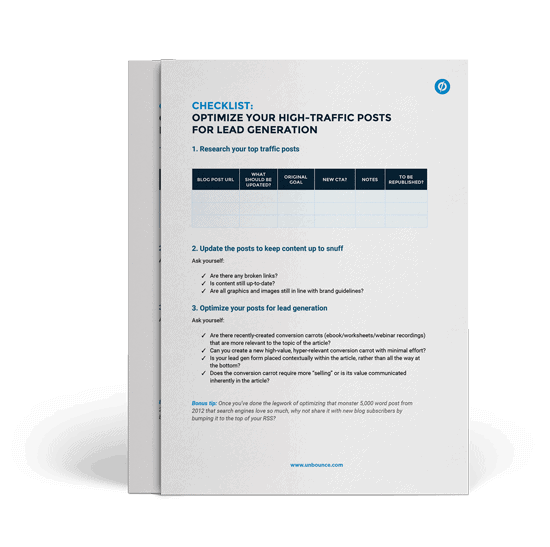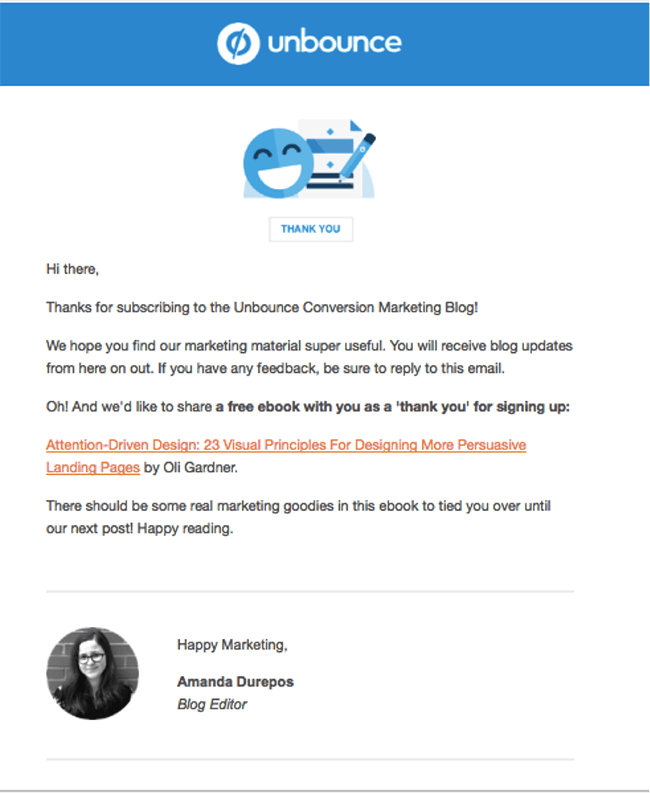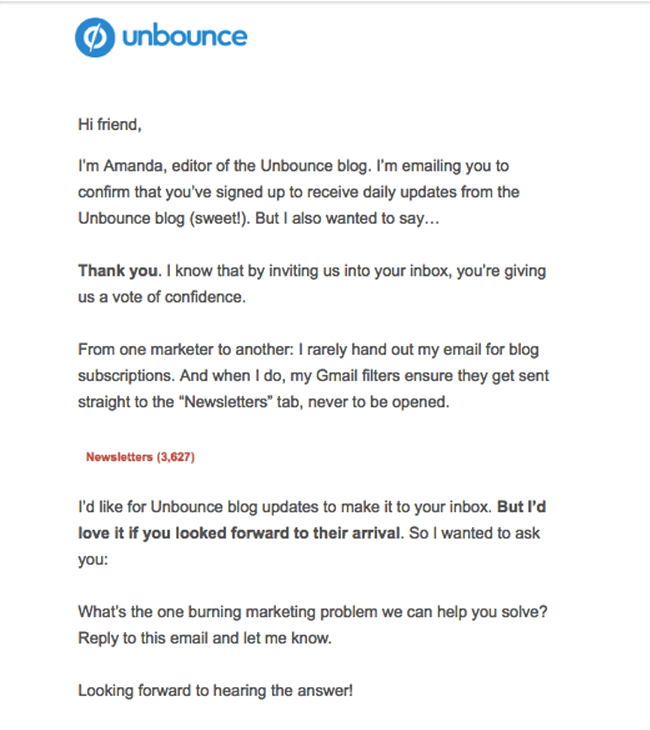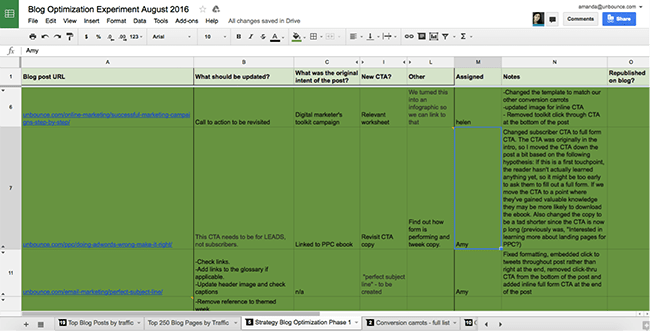In my kitchen I have a poster that reads, “SLOW DOWN.”

It’s a simple reminder, but one that I need constantly. Walk more slowly. Stop and appreciate the simple things. Take a break and call your mom.
We live in an era of high-speed internet and keyboard shortcuts and push(y) notifications and instant gratification. Even our food is expected to be fast — slap a patty on the bun and get the customer their order as quickly as possible.
Sometimes, content creation can feel a little like that: pump out piece after piece. Slap on a lead gen form. Run the reports. Rinse and repeat until you grow old and gray.

Of course, there isn’t anything inherently wrong with being a productive content producer! ?
But it’s problematic if you get so caught up in the daily grind that you never take a step back and look critically at your day-to-day work and processes.
Which is why the Unbounce content team decided to halt publishing for two weeks: so we could slow down, do our research and find opportunities for experimentation and optimization.
The optimization work we did in this two-week period gave us a welcomed break from feeling like we were on a hamster wheel at a content farm. But it also brought us measurable results that exceeded our expectations (and that of our bosses):
- 274% more conversions from our 17 highest traffic posts
- More engagement from our readers
- A better understanding of our audience and what they’d like to see next so we can keep creating relevant, high-converting content

We achieved all that by slowing down, taking a step back and finding small areas for improvement and experimentation.
But if we weren’t producing fresh content, what in the heck were we doing (and how can you do it too)?
I’ll tell you right now… if you promise to call your mom later.
Phase I: Optimize high traffic posts (especially for lead gen)
If you do any digging around in Google Analytics, you may notice that the same 5-10 posts consistently bring you the most traffic month after month. Most often, these are posts on high-interest topics that you’re ranking for in search engines.
For us, some of these posts dated as far back as 2012. And while the content was still relevant and actionable, there was always something to optimize — especially in regards to lead generation.
We created a spreadsheet with our 20 highest-traffic posts for the past month. It looked a little something like this:
The blog team (comprised of Helen, Amy and I) took a close look at each post and determined whether it was evergreen and if it still met our editorial standards:
- Are there any broken links?
- Is content still up to date?
- Are all graphics and images still in line with brand guidelines?
Making sure that you can still stand behind older content is key — but for us, the focus of our optimization lay in the calls to action…
Optimize for lead generation
Some of our high-traffic posts linked to outdated assets or had lead gen forms all the way at the bottom, buried under 3,000 words.
What’s worse — we found that some of these posts were dead ends, with no clear “next step” for readers.

Updating your high-traffic posts for lead generation is when things really get interesting. Ask yourself:
- Are there recently created conversion carrots (ebook/worksheets/webinar recordings) that are more relevant to article topic? Especially for really old posts, we had a ton of new assets to choose from.
- Can you create a new high-value, hyper-relevant conversion carrot with minimal effort? In one case, we created an email subject line worksheet that we thought would be valuable to readers.
- Is your lead gen form placed contextually within the article, rather than all the way at the bottom? It should come as no surprise that we’ve run heat map tests that reveal most people don’t make it to the bottom of the page. Test incorporating forms contextually into the post — we generally place inline forms no lower than 1/3 of the way through the post.
- Does the conversion carrot require more “selling” or is its value communicated inherently in the article? If it’s a simple asset that has been explained by the post, test an inline form like the one below. If you’re giving away something that requires a bit of explanation (like a breakdown of ebook chapters), test linking to a landing page.

Ready to optimize your high-traffic posts for lead gen?
All that work seems to have paid off so far.
In total, we optimized 17 posts. In a one-month period before the experiment, organic traffic to these posts brought us a total of 248 conversions (form completions).
One month post-optimization, those same 17 posts brought us 928 conversions — a 274% increase.
Phase II: Get to know your leads
Okay, phase two sounds less sexy than phase one, which promised you’d “get more leads.”
But it’ll pay off in the long run.
Because the end goal of any business usually isn’t to “generate leads.” It’s to make money.
And if you want to generate more of the right type of leads who are more likely to fall in love with you and your solution and eventually become customers, then you need to get to know who you’re talking to.
Because a billion blog subscribers are useless to you if none of them are dealing with a problem your product solves.
We dedicated about half our time during the two-week experiment to learning more about our dear readers to better understand their pains and goals so we could serve them up more of what they want.
Ask your readers what they want
Generating leads gives you quantitative feedback about whether your content is desirable, but sometimes all you need to do to determine what readers want is to… just ask.

During our hiatus, we did two things to better get to know our prospects.
1. Survey says…

In our blog post giving readers a heads up that we were going to cool it for two weeks to optimize some stuff, we sent readers to a Typeform survey.
You can take the survey and steal the questions we used here.
2. Encourage engagement on blog welcome emails
We also wanted to be able to engage with readers in a more personal way — potentially even start a discussion — to show that there are living, breathing humans behind our blog.
Plus, we knew we could do better than our old welcome email:

We updated this welcome email to sound more like it was coming from a human rather than a business. Most importantly, though, we prompted new subscribers to reply to the email with a marketing problem that is currently baffling them:

Before this email, I rarely received replies to the welcome email. I honestly can’t think of a single reply.
As I’m writing this post, the new welcome series has been live for a week, and I’ve received a handful of really thoughtful replies to this email. I anticipate many, many more.
It allows me to get to know our readers in a super personal way, while over-delivering in value by offering advice when I can. Bonus? If I get the same question again and again, I can answer it with a blog post. :)
Would we do it all again?
Our blog publishing hiatus allowed us to meet business goals in a way that will keep on giving — by organically bringing in more leads every month.
It allowed us to take the time to treat our readers like humans and really listen to what they want more of (so we can continue to #dobetter on the blog).
But the hiatus had unintended results too — we had more time and perspective to discuss the structure of the blog team and who should own what (the subject of its own post, perhaps?).
It allowed us to meet our personal goals of feeling excited about our work by stepping back and experimenting with new things.
Maybe you’ve heard us say this (about 51 times) before…

I think we’d be fools not to do it again!

